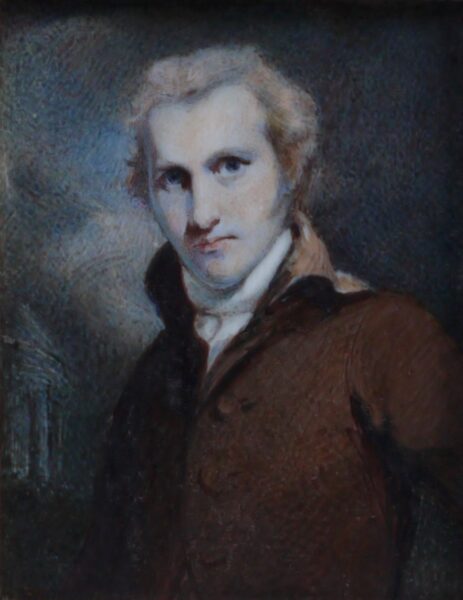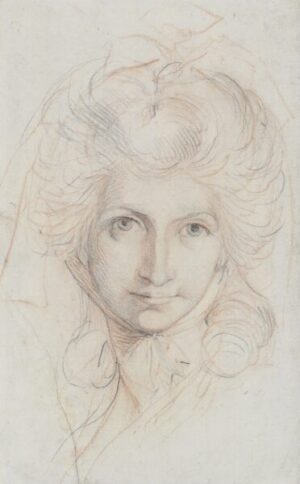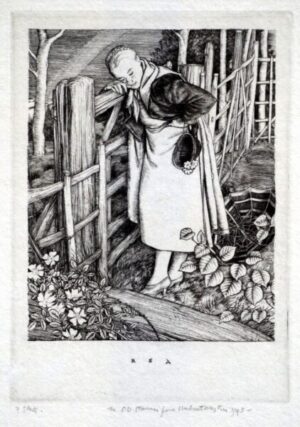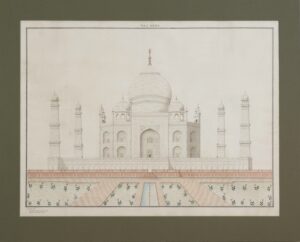Description
Charles Heathcote Tatham was a celebrated architect who built and did additions to many Stately Homes of England. He also designed and built the Portrait Gallery at Castle Howard near York. His daughter Julia married the painter George Richmond.
Our miniature was probably painted around 1830 during the time that Richmond was giving drawing lessons to Mr. Tatham’s daughters, and where he met and fell in love with Julia. The miniature-portrait is a copy taken from a painting by Thomas Kearsley (1773-circa 1802) exhibited: R.A. 1799. No. 161. Later the portrait by Kearsley was owned by George Richmond until it was sold at Christie’s a year after he died, 1 May 1897. In 1874 George Richmond also painted a larger version of the portrait onto canvas (23 x 19 in.) that was nearer to the size of the original (24 x 20 in.) Richmond’s 1874 version of the portrait was sold at Sotheby’s in London on July 4. 2001. Lot 134. For the total price of £5000.
In 1799 Charles Tatham entered a Competition for the design of the Nelson Memorial in Trafalgar Square. Owing to a delay in the result of the Competition he published his designs, and it is possible that the ensuing Court Cases about this matter were the reason for his diminished financial circumstances. In 1834 “dire misfortune befell”. His wife, Harriet, died, and his house and valuable collections were sold. In 1837 he was appointed Warden of Greenwich Hospital, and afterwards Holy Trinity Hospital, Greenwich. (Some accounts say it was Norfolk College, Greenwich.) He died in 1842 and was buried in the Chapel of Holy Trinity Hospital, Greenwich. A beautiful watercolour portrait in his uniform of that time, was painted by his son, Frederick Tatham, R.A. and is in possession of Mr. Bill Tatham in Johannesburg. It was given to him by the Richmond family. A large Crayon portrait by B. R. Haydon dated 1823 is in the Print Room at the British Museum.
George Richmond and Julia Tatham, eloped to Gretna Green to be married on January 24, 1831 after Charles Tatham, ‘having fallen on hard times’ withdrew his support for Julia’s marriage on receiving an offer for his daughter’s hand from a rich an elderly peer. Palmer lent Richmond £40 and Richmond also noted a loan of £12 from Henry Walter. It was a happy marriage, the couple remained in love throughout their long years together.
Brand
Richmond, George (1809-1896)
George Richmond was born to Thomas and Ann Richmond on the 28th March 1809. A natural facility for draftsmanship revealed itself at an early age. He is one of the youngest students ever to have been admitted to the Royal Academy schools. The Academy permanent collection holds drawings made by Richmond while studying in the school of the Antique.
In 1825 he met William Blake and, along with Samuel Palmer and fellow student Edward Calvert, became devoted to the aging artist. The young men would come to refer to themselves as the Ancients. The group followed the artistic principles of Blake and worked to ideals inspired by renaissance painters, particularly Michelangelo and Dürer. The party retired to Palmer's country home at Shoreham during the late 1820's, residing together and developing their aesthetic theory. They lived simply and worked hard.
In 1831 Richmond married Julia Tatham, daughter of Charles Heathcote Tatham. The marriage was immediately central to his life and they were to have thirteen children, ten of whom survived into adulthood. The necessities resulting from such a large family compelled Richmond to change direction artistically. It was impossible to follow the eclectic road taken by the Ancients and feed all the hungry mouths. The ramifications of this situation remained with Richmond for the rest of his professional life.
Richmond was an extremely religious young man. His beliefs chimed with the growth of evangelical devotion and he found a fellow communion among the members of the "Clapham Sect". Sir Robert Inglis was an early supporter of Richmond, and benefactor to the children of Henry Thornton, one of the founders of the Clapham group. It was through Inglis that Richmond received an important commission in 1832. Richmond landed a coup in painting the great emancipator, William Wilberforce. The positive public response to this portrait established Richmond, almost overnight, with a successful portrait practice.
From the early 1830's portrait painting became Richmond's primary source of income. By the late 1830's his financial security was such that he could afford to travel to Italy with his young family and that of Samuel Palmer. Richmond's experiences in Italy are recorded in his journals, which comprise part of this archive.
Richmond rarely left Britain after a second journey to Rome in 1840-1841. He worked hard over the next forty years, painting around 2500 of the most prominent figures of Victorian society. His learning in art practice and art history led him to be considered one of the country's foremost experts on painting restoration. This discipline took on more importance for him as his energies for portrait work flagged in the 1870's and 1880's. His residence, Porch House, in Potterne, Wiltshire, was regarded as a model of sensitive architectural restoration. He declined the position of director of the National Gallery at least once, citing ill health. Health was a perennial concern of this long-lived hypochondriac.
Julia Richmond died in 1881 and from this point Richmond entered the last, relatively secluded phase of his life. His closeness to the survivors of the Thornton clan is particularly evident towards the close of his life. Richmond died in 19th March 1896; having seen his son William Blake Richmond elected a Royal Academician the year before.



